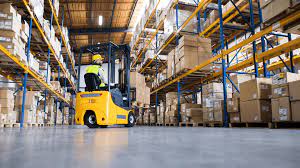Introduction:
Warehousing is an essential component of the logistics industry, serving as a hub for storage, packaging, and distribution of goods. The COVID-19 pandemic has further highlighted the significance of warehousing, with e-commerce sales reaching record highs and supply chain disruptions. As we move further into the future, the warehousing industry will continue to evolve, driven by emerging technologies, increasing demands for sustainability, and changing customer expectations. In this article, we will explore the predictions for the future of warehousing in 2023 and beyond.

Technology:
Technological advancements have transformed the warehousing industry, improving efficiency, accuracy, and productivity. In the coming years, we can expect the integration of more sophisticated technology, such as Artificial Intelligence (AI), Internet of Things (IoT), and robotics. AI will enable warehouses to predict demand, optimize inventory management, and automate repetitive tasks. IoT will allow for real-time monitoring of inventory levels, location tracking, and temperature control. Robotics will enhance picking, packing, and sorting operations, reducing the need for human intervention. Moreover, blockchain technology will enable greater transparency and traceability across the supply chain, providing customers with more information about their products’ journey.
Sustainability:
Environmental concerns have become increasingly important to customers, and warehousing operations will have to adapt to meet these expectations. Sustainable warehousing practices, such as renewable energy, waste reduction, and carbon footprint reduction, will become more prevalent in the coming years. Warehouses will incorporate energy-efficient lighting systems, heating and cooling systems, and adopt renewable energy sources such as solar panels and wind turbines. Furthermore, the reduction of packaging waste will be a crucial area of focus, with warehouses exploring more sustainable alternatives such as biodegradable materials, reusable packaging, and closed-loop systems.

Customer Demands:
Customer expectations have shifted in recent years, with a growing emphasis on speed, flexibility, and convenience. As a result, warehousing operations will have to adapt to meet these demands. In the future, we can expect more same-day and next-day delivery options, more flexible delivery windows, and greater customization options. Warehouses will utilize predictive analytics to anticipate customer needs, allowing them to optimize inventory levels and meet demand more efficiently. Additionally, the rise of omnichannel retail will continue, requiring warehouses to seamlessly integrate online and offline operations.
The future of warehousing will be defined by technology, sustainability, and customer demands. The integration of emerging technologies, sustainable warehousing practices, and the need to meet changing customer expectations will transform the industry in the coming years. Warehouses that are able to adapt to these changes and adopt new technologies and practices will be well-positioned to succeed in the future.
However, the challenges that come with these changes should not be overlooked. Warehouses will need to invest heavily in technology, retrain their workforce, and reevaluate their current processes and operations to keep up with the fast-changing landscape. Moreover, sustainability initiatives may come at a higher cost, which could affect profit margins. However, the benefits of sustainability initiatives, such as reduced waste, energy savings, and improved brand reputation, will likely outweigh the costs in the long run.
Another critical aspect that warehouses will need to consider is cybersecurity. As technology plays an increasingly prominent role in warehousing operations, the risk of cyberattacks also increases. Warehouses will need to invest in robust cybersecurity measures to protect their operations from cyber threats, safeguard customer data, and prevent supply chain disruptions.

In addition to these challenges, there are also potential ethical implications to consider. As automation and robotics become more prevalent in warehousing operations, there may be concerns about job displacement and worker exploitation. Warehouses will need to ensure that they prioritize the well-being of their workforce and implement fair labor practices.
Finally, the future of warehousing will be closely tied to the overall development of the logistics industry. As new technologies and practices emerge, warehouses will need to coordinate with other supply chain actors to ensure that they are able to operate efficiently and effectively. This coordination will be especially critical in the face of potential disruptions such as natural disasters, geopolitical tensions, or pandemics.
The Impact of Emerging Technologies on Warehousing Operations
The rise of new and emerging technologies is set to have a significant impact on warehousing operations in the years to come. One key area of focus is automation. Automated technologies such as autonomous vehicles, robotics, and artificial intelligence are already transforming warehousing operations, and this trend is set to continue in the coming years. These technologies can help warehouses to operate more efficiently, improve accuracy and speed, and reduce costs.
Another area of focus is the Internet of Things (IoT). By embedding sensors and other IoT devices into their operations, warehouses can collect and analyze large amounts of data in real-time. This can help them to optimize their operations, improve visibility and transparency, and better understand their customers.

Sustainability in Warehousing Operations
Sustainability is another critical area of focus for warehousing operations. As consumers become more environmentally conscious, they are increasingly looking for products that are produced in a sustainable manner. Warehouses will need to adapt to this changing landscape by implementing sustainable practices throughout their operations. This could involve investing in renewable energy sources, reducing waste, and adopting more sustainable packaging materials.
Furthermore, warehouses will also need to focus on reducing their carbon footprint. This could involve investing in more energy-efficient equipment, using alternative transportation methods such as electric vehicles or biofuels, and implementing measures to reduce energy usage and waste.
Challenges and Ethical Considerations
While there are certainly opportunities to be found in the future of warehousing, there are also challenges and ethical considerations that will need to be addressed. One of the biggest challenges is cybersecurity. As technology plays an increasingly prominent role in warehousing operations, the risk of cyberattacks also increases. Warehouses will need to invest in robust cybersecurity measures to protect their operations from cyber threats, safeguard customer data, and prevent supply chain disruptions.
Conclusion
The future of warehousing is set to be shaped by a range of factors, including emerging technologies, sustainability, and changing customer expectations. Warehouses that are able to adapt and invest in these areas will be well-positioned to succeed in the coming years. However, they will need to navigate a range of challenges, including cybersecurity, ethical considerations, and coordination with other supply chain actors. By carefully evaluating these challenges and opportunities, warehouses can position themselves to thrive in a dynamic and rapidly evolving logistics landscape.



